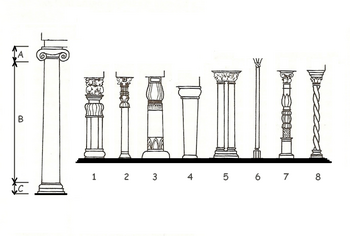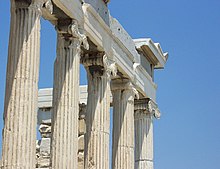Column (architecture)
A column (same word in Latin, derived from volume, "support", "support") is an element vertical architectural and that normally has structural functions, although they can also be chosen for decorative purposes. Ordinarily, its section is circular, because when it is quadrangular it is usually called a pillar, or a pilaster if it is attached to a wall.
The classical column is made up of three elements: base, shaft and capital.
The "base" It would correspond to the stump of the tree, the stem to the trunk, and the capital to the birth of its thickest branches. According to this analogy, authors such as Vitruvius think that the primitive columns imitated trees, since in reality they ended up replacing the trunks with more durable stone columns, also leading, continuing with the analogy, to see in the grooves of the shafts the bark of the tree.
History
All the great Iron Age civilizations in the Near East and the Mediterranean have used columns. In the architecture of ancient Egypt as early as 2600 BC. C., the architect Imhotep made use of stone columns. He was inspired by the forms of the vegetal nature of his land to transform and imagine the bundles of reeds used in his primitive lodgings as supporting elements in the form of columns, a basic component of stone architecture. Later, the cylindrical shaft was also used. The decoration of its shafts can be assimilated to tied reeds and its capitals, stylizations of floral motifs in the form of lotiform (lotus flower), papyriform (papyrus umbel), palmiform (palm leaf) or bell-shaped.
Some of the most elaborate columns in the ancient world are those of the Persians, especially the huge columns erected at Persepolis whose capitals were decorated with bull protomes. The Egyptians, Persians and other ancient civilizations used the columns, in a practical way, to support the roofs of their buildings, externally decorated with reliefs or paintings.[citation required]
The Greco-Roman civilization, in fact, used columns both inside and outside buildings, especially in porticoes, and it was the Greeks who developed the classical orders of architecture.[ citation required]
Columns, or at least structural exteriors, were less important in medieval architecture, and classical forms were abandoned in both Byzantine, Romanesque, and Gothic architecture in favor of more flexible forms, with capitals of different types of vegetal or figurative decoration. Renaissance architecture, wanting to revive classical vocabulary and styles, using variations of the classical orders, remained a model for the subsequent training of architects in Baroque, Rococo and Neoclassical architecture.[citation required]
The Industrial Revolution promoted the construction of buildings with steel and reinforced concrete pillars, making it possible to create exterior enclosures without structural functions, with facades without pillars and fully glazed: the curtain wall. Modern architecture, functionalism or sustainable architecture are some ways of conceiving architectural design in recent centuries.[citation required]
Column Components and Examples
A column is usually made up of three elements:
- A – Capitel
- B – Fuste
- C – Basa
In classical architecture, the shaft rests on the base and the element that supports the column rests on the capital. The proportions and decoration of these elements are governed by the architectural orders.
See illustration of the three components in an Ionic order column. Other examples of columns with different architectural styles:
- Hindu
- Persian
- Egyptian
- Crete
- Romanesque
- Gothic
- Renaissance
- Baroque
Classification
In relation to other building components
Based on their arrangement in relation to other components of a building, these types of columns can be distinguished:
- Insulated or exempt column: The one that is separated from a wall or any vertical element of construction or construction.
- Side column: The one that is juxtaposed to a wall or another element of the building.
- Embedded Column: The one that appears to be partially embedded in the wall or other body of construction.
- Column delivered or delivered: The one that is attached but whose fuse is not of one piece, but formed by pieces that are embedded in the wall, forming part of it.
According to classical architectural orders
Due to its belonging to one of the classical architectural orders, the column can be:
- Draric column
- Ionical column
- Corinthian column
- Tuscan column
- Composite column
According to the stem
Taking the whole for the part, it is usual to classify the columns according to the type of shaft they have. Thus, the following could be related:
- Smooth column: the one that has neither acanals nor ornaments.
- Column grouped: the one with several fuses with a common base and capital (typical of the Gothic).
- Striated or achanneled column: the shape of which has ornamental stretches or acanalatures in all its length.
- Fasciculate column: the one that is made up of a series of slender cysts, similar, grouped as beam.
- Fajada or ringed column: The one that has its fuse torn in drums, rings or different diameter fajas.
- Twinned column: the one with a double fuse.
- Romanesque column: the one that has its cylindrical fuse and does not have vertical acanalatures as in classical architecture, but rather smooth or, in the most complex case, has sogueados or geometric decoration (zigzag) or vegetable.
- Psalomonic column: the one that has torsioned a spiral (typical of Baroque art).
- Torsa Column: The one with its fuse decorated with helically arranged motifs.
Memorial column
A unique case is the so-called commemorative column. It is not a structural piece of any construction, but constitutes in itself a commemorative monument to commemorate some relevant event or person. On a high podium a large shaft can be raised, decorated with bands of bas-reliefs that cover its entire surface, and at the upper end, as a pinnacle, a figure or statue can be raised.
The Romans used it to commemorate events of national importance or to glorify their emperors. Famous are Trajan's column erected around the year 113 in Trajan's Forum, in Rome, to celebrate the conquest of Dacia, or the column of Marcus Aurelius that was erected in the Antoninus forum around 180 (today in Colonna de Rome) to commemorate the victories over the Germans.
In times after the Roman Empire, this type of triumphal monument has continued to be used, of which notable examples are the Vendôme Column in Paris dedicated to Napoleon Bonaparte, Nelson's Column in London's Trafalgar Square, the Column of independence in Mexico City or the columns of the discoverer Christopher Columbus in Barcelona or Madrid.
Contenido relacionado
Millennium Dome
Guido molinari
Chinese art




